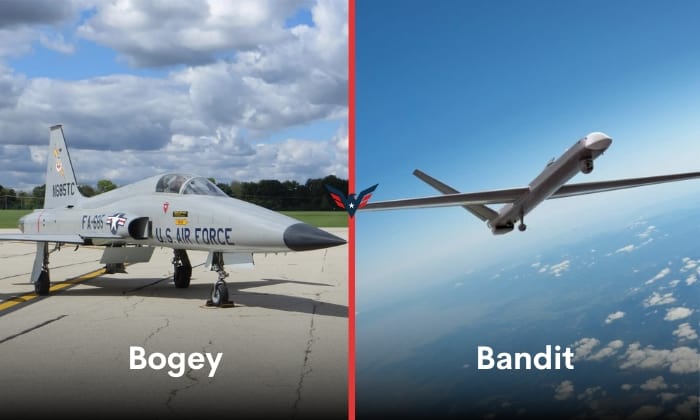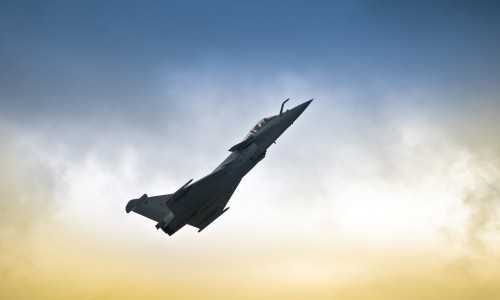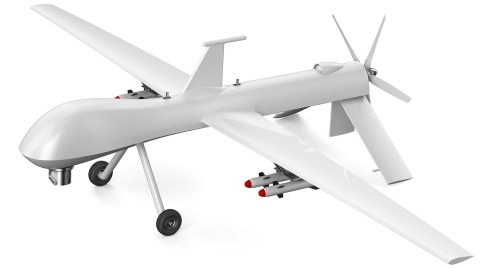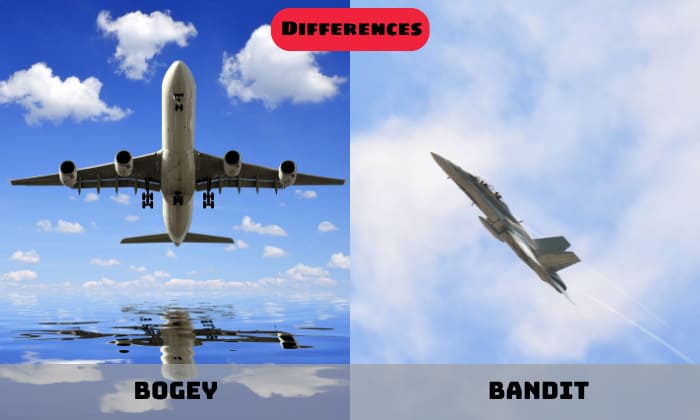In the realm of military aviation, the terms “bogey” and “bandit” hold significant importance. They are often used interchangeably but carry distinct meanings.
Understanding the difference between these terms is crucial for fighter pilots and those involved in aerial engagements. This bogey vs. bandit guide aims to shed light on the disparities between bogeys and bandits, their identification in aerial combat, and the significance of distinguishing them.
In short, a bogey is an unidentified aircraft that has unknown intentions or nature, while a bandit is a confirmed hostile aircraft.
| Bogey | Bandit | |
| Show Up on ATC | Yes | No |
| Identification | – Has not been positively identified as friendly or hostile
– Unknown intentions or nature |
– Confirmed hostile
– Highly an enemy threat |
| Threat Level | – Not necessarily a threat | – Considered a threat |
| Response | Further observation or investigation required | Requires defensive/offensive measures |
| Engagement | Not automatically engaged or targeted | Considered a legitimate target for offensive action, but not an indication to engage. |
| Context | Applies to unidentified aircraft in general | Used in air combat situations for confirmed hostile aircraft |
Table of Contents
Overview
The terms bogey and bandit are primarily used in military scenarios, particularly in air combat and air defense operations. Fighter pilots, radar operators, and air defense systems use these terms to communicate and track potential threats in real-time situations.
1. Bogey
A bogey refers to any unidentified aircraft in an airspace. It can include friendly aircraft, unknown aircraft, or potentially hostile aircraft that have not yet been identified as such. That said, it does provide its identifying code via its transponder.
Bogeys do not respond to air traffic control (ATC). However, they still appear on ATC displays and can be detected through radar systems, so you can still easily pinpoint and track them.
In World War II, a bogey is a confirmed hostile aircraft that poses an immediate threat and are considered adversaries. But today, they are used to refer to an unidentified aircraft whose intentions still remain unclear.
2. Bandit
On the other hand, a bandit is an unidentified aircraft that does appear on ATC displays whatsoever. They have a transponder, but, like bogeys, they are not responding to ATC communications.
Usually, bandits fly without clearance or permission from the ATC. They are usually aircraft positively identified as a threat to friendly forces. However, this does not necessarily indicate an order to engage directly.
Types
1. Bogey
Bogeys are not categorized into types like bandits. They are usually military aircraft of instrument flight rules (IFR) aircraft.
2. Bandit
- Fighter Jets
Fighter jets are often the primary types of bandits encountered in aerial engagements. These high-performance aircraft are designed for air-to-air combat and possess advanced weaponry and maneuverability, making them formidable adversaries in the sky.
- Unmanned Aerial Vehicles (UAVs) Or Drones
With the increasing prevalence of unmanned aircraft, drones have become a significant concern in modern warfare. They can be used for surveillance, reconnaissance, and even weapon delivery, posing a serious threat to friendly forces. Drones can vary in size and capabilities, ranging from small quadcopters to larger, long-range UAVs.
- Weather Balloons
While less common in contemporary warfare, weather balloons have been historically misidentified as potential bandits. These large, hydrogen or helium-filled balloons are used for meteorological purposes and can drift into military airspace, leading to confusion during aerial engagements.
- Tally Bandits
The term “tally” is a fighter pilot jargon used to indicate visual contact with an aircraft. “Tally bandit” refers to the confirmation of a hostile aircraft. Once a pilot visually acquires the bandit and establishes hostile intent, it becomes a verified threat.
Differences
1. Identification
A bogey refers to an unidentified aircraft that has not been positively identified as friendly or hostile. It may be an unknown aircraft, a friendly aircraft without proper identification, or a potentially hostile aircraft.
In contrast, a bandit plane is usually a confirmed hostile aircraft that has been positively identified as an enemy threat.
2. Threat Level
A bogey does not necessarily imply an immediate threat. It signifies that the aircraft’s identity or intentions are unknown, and further observation or investigation is required to determine its nature.
A bandit, however, is considered an adversary and poses an immediate threat. It is an enemy aircraft that is actively engaged in hostile actions or is intending to engage in hostile actions.
3. Response
When a bogey aircraft is detected, procedures are typically followed to determine its identity and intentions. It may involve attempting to establish communication with the aircraft, visual observation, or radar tracking to gather more information.
Once a bogey is positively identified as a hostile aircraft, it is then referred to as a bandit. At that point, appropriate defensive or offensive measures can be taken to counter the threat.
4. Airborne Threat Identification Guide
Identifying bogeys relies on radar detection and visual observation. Radar systems help detect the presence of unknown aircraft in an airspace, while visual cues provide further information for classification.
Communication between air defense units and pilots also plays a significant role in identifying bogeys. Bandits, in addition to radar detection and visual cues, are usually confirmed through communication channels that verify the aircraft’s hostile intent and designation.
Importance of Distinguishing Bogeys & Bandits
The ability to differentiate between the bandit and bogey military meaning is of utmost importance in aerial engagements. Proper identification in aerial engagements enables military forces to assess potential threats accurately.
Distinguishing between friendlies, unknowns, and potentially hostile aircraft aids in making informed decisions and taking appropriate defensive measures. Additionally, recognizing bandits allows for a timely response to imminent danger, initiating combat operations to neutralize hostile forces effectively.
In addition, concise and accurate communication is essential in aircraft operations. Using the correct terminology to describe an unknown aircraft can help avoid confusion and ensure that everyone involved is on the same page.
Frequently Asked Questions
What is the origin of the terms “bogey” and “bandit” in military aviation?
A: The term “bogey” originated from World War II fighter pilot jargon, derived from the word “bogy,” meaning a person that causes worry. “Bandit,” on the other hand, stems from its common usage in slang to describe an outlaw or robber.
How does the Air Force finance the identification of bogeys and bandits?
A: The Air Force allocates significant resources to radar detection systems, airborne surveillance platforms, and advanced communication technologies. These investments help finance the identification and tracking of bandit and bogey Air Force and ensure air superiority and protect friendly forces.
How is a bandit different from a hostile aircraft?
Hostile aircraft are positively identified as an enemy threat and satisfy the conditions specified in the rules of engagement. In such cases, fighters have the necessary authorization to engage and take defensive or offensive measures, which may include shooting down the airborne targets if deemed necessary.
As for bandits, the term is a confirmation that the aircraft is recognized as potentially hostile. However, it’s not a direct indication that fighters should engage.
Conclusion
In the dynamic world of military aviation, distinguishing between bogeys and bandits is essential. The terms hold distinct meanings and serve different purposes in identifying airborne threats.
Proper identification enables effective decision-making, response to imminent danger, and the initiation of combat operations against hostile forces. Understanding the disparities of bogeys vs. bandits remains a vital aspect of aerial combat terminology, ensuring the safety and success of military aviation.

I am Everett Bledsoe, taking on the responsibility of content producer for The Soldiers Project. My purpose in this project is to give honest reviews on the gear utilized and tested over time. Of course, you cannot go wrong when checking out our package of information and guide, too, as they come from reliable sources and years of experience.








